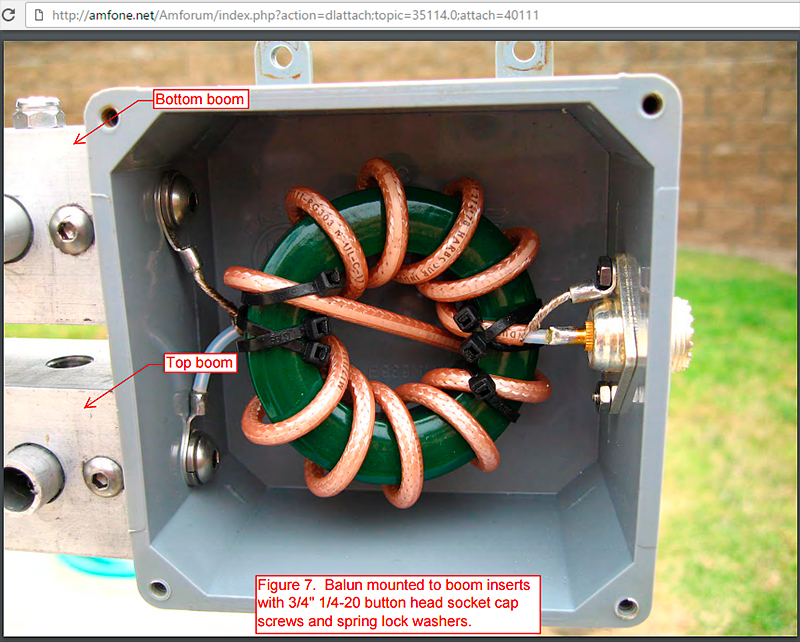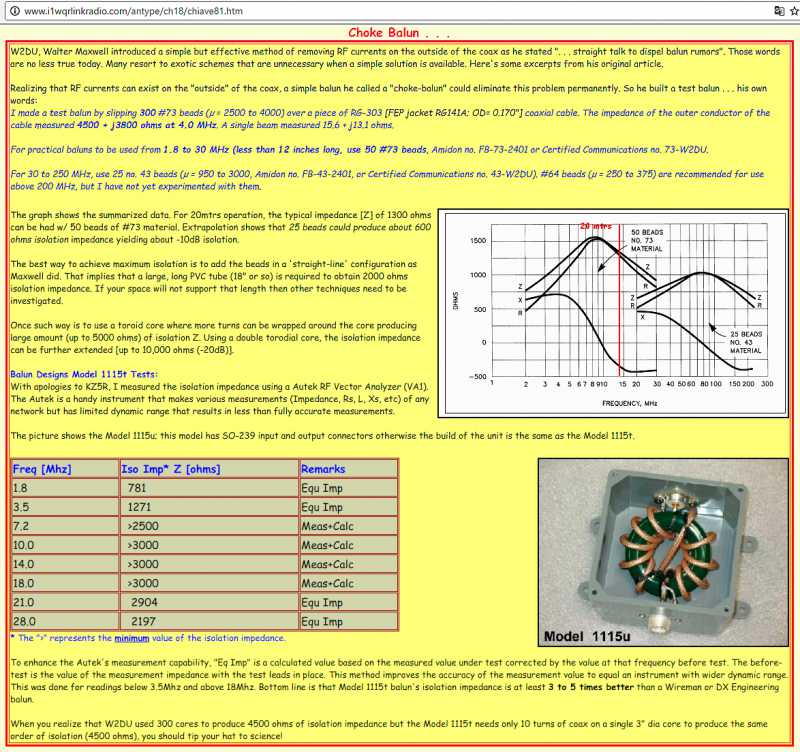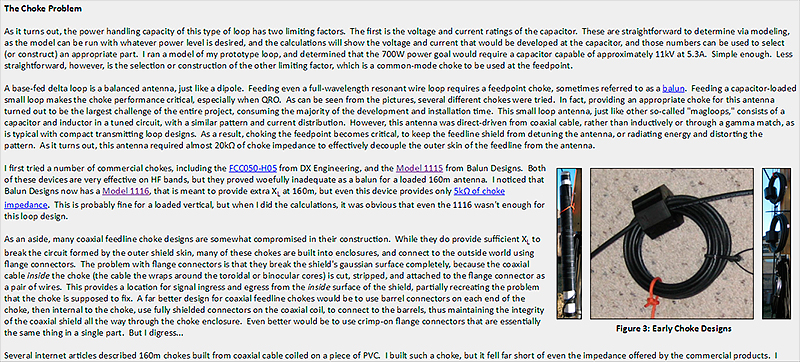Hola a tod@s..
Alguien sabe que tipo de toroide lleva el Balun designs modelo 1115 o 1116?????
Las medidas corresponden a un t240/??
diametro ext: 6 cm.
diametro int; 4 cm.
altura: 1 cm.
Color todo verde, pero ya se sabe que eso no es de todo significativo dependiendo del fabricante..
73 Quique
QUIQUE - EA1DFP
Escribió:... tipo de toroide Color todo verde...
Desconozco que tipo de toroide utiliza el modelo Model 1115 de Balun Designs,
pero dice que aguanta 5000 watios para las frecuencias de 1.5 a 54 MHz.
En esta fotografía se aprecia que es de color verde, con cable "RG-303"
He visto la web de K6JRF (Anteriormente W6FZC) y al final de la pagina pone esto:
W2DU, Walter Maxwell introduced a simple but effective method of removing RF currents on the outside of the coax as he stated ". . . straight talk to dispel balun rumors". Those words are no less true today. Many resort to exotic schemes that are unnecessary when a simple solution is available. Here's some excerpts from his original article.
Realizing that RF currents can exist on the "outside" of the coax, a simple balun he called a "choke-balun" could eliminate this problem permanently. So he built a test balun . . . his own words:
I made a test balun by slipping 300 #73 beads (µ = 2500 to 4000) over a piece of RG-303 [FEP jacket RG141A; OD= 0.170"] coaxial cable. The impedance of the outer conductor of the cable measured 4500 + j3800 ohms at 4.0 MHz. A single beam measured 15.6 + j13.1 ohms.
For practical baluns to be used from 1.8 to 30 MHz (less than 12 inches long, use 50 #73 beads, Amidon no. FB-73-2401 or Certified Communications no. 73-W2DU.
For 30 to 250 MHz, use 25 no. 43 beads (µ = 950 to 3000, Amidon no. FB-43-2401, or Certified Communications no. 43-W2DU). #64 beads (µ = 250 to 375) are recommended for use above 200 MHz, but I have not yet experimented with them.
The graph shows the summarized data. For 20mtrs operation, the typical impedance [Z] of 1300 ohms can be had w/ 50 beads of #73 material. Extrapolation shows that 25 beads could produce about 600 ohms isolation impedance yielding about -10dB isolation.
The best way to achieve maximum isolation is to add the beads in a 'straight-line' configuration as Maxwell did. That implies that a large, long PVC tube (18" or so) is required to obtain 2000 ohms isolation impedance. If your space will not support that length then other techniques need to be investigated.
Once such way is to use a toroid core where more turns can be wrapped around the core producing large amount (up to 5000 ohms) of isolation Z. Using a double torodial core, the isolation impedance can be further extended [up to 10,000 ohms (-20dB)].
Balun Designs Model 1115t Tests:
With apologies to KZ5R, I measured the isolation impedance using a Autek RF Vector Analyzer (VA1). The Autek is a handy instrument that makes various measurements (Impedance, Rs, L, Xs, etc) of any network but has limited dynamic range that results in less than fully accurate measurements.
The picture shows the Model 1115u; this model has SO-239 input and output connectors otherwise the build of the unit is the same as the Model 1115t.
Freq .. Iso Imp* ... Remarks
MHZ ... Z ohms.....
1.8 ..... 781 ......... Equ Imp
3.5 ..... 1271 ......... Equ Imp
7.2 ..... >2500 ...... Meas+Calc
10.0 ... >3000 ...... Meas+Calc
14.0 ... >3000 ...... Meas+Calc
18.0 ... >3000 ...... Meas+Calc
21.0 ... 2904 ......... Equ Imp
28.0 ... 2197 ......... Equ Imp
* The ">" represents the minimum value of the isolation impedance.
To enhance the Autek's measurement capability, "Eq Imp" is a calculated value based on the measured value under test corrected by the value at that frequency before test. The before-test is the value of the measurement impedance with the test leads in place. This method improves the accuracy of the measurement value to equal an instrument with wider dynamic range. This was done for readings below 3.5Mhz and above 18Mhz. Bottom line is that Model 1115t balun's isolation impedance is at least 3 to 5 times better than a Wireman or DX Engineering balun.
When you realize that W2DU used 300 cores to produce 4500 ohms of isolation impedance but the Model 1115t needs only 10 turns of coax on a single 3" dia core to produce the same order of isolation (4500 ohms), you should tip your hat to science!
Carlos EC1T
Ex. EA1DVY
Soria in81
- En la web de kk5jy dice el Model 1115 , que se queda algo corta para la banda de 160m??
I first tried a number of commercial chokes, including the FCC050-H05 from DX Engineering, and the Model 1115 from Balun Designs. Both of these devices are very effective on HF bands, but they proved woefully inadequate as a balun for a loaded 160m antenna. I noticed that Balun Designs now has a Model 1116, that is meant to provide extra XL at 160m, but even this device provides only 5kΩ of choke impedance. This is probably fine for a loaded vertical, but when I did the calculations, it was obvious that even the 1116 wasn't enough for this loop design.
As an aside, many coaxial feedline choke designs are somewhat compromised in their construction. While they do provide sufficient XL to break the circuit formed by the outer shield skin, many of these chokes are built into enclosures, and connect to the outside world using flange connectors. The problem with flange connectors is that they break the shield's gaussian surface completely, because the coaxial cable inside the choke (the cable the wraps around the toroidal or binocular cores) is cut, stripped, and attached to the flange connector as a pair of wires. This provides a location for signal ingress and egress from the inside surface of the shield, partially recreating the problem that the choke is supposed to fix. A far better design for coaxial feedline chokes would be to use barrel connectors on each end of the choke, then internal to the choke, use fully shielded connectors on the coaxial coil, to connect to the barrels, thus maintaining the integrity of the coaxial shield all the way through the choke enclosure. Even better would be to use crimp-on flange connectors that are essentially the same thing in a single part. But I digress...
73
Carlos EC1T
Ex. EA1DVY
Soria in81
EA1DFP escribió:Hola a tod@s..
Alguien sabe que tipo de toroide lleva el Balun designs modelo 1115 o 1116?????
Las medidas corresponden a un t240/??
diametro ext: 6 cm.
diametro int; 4 cm.
altura: 1 cm.
Color todo verde, pero ya se sabe que eso no es de todo significativo dependiendo del fabricante.. 73 Quique
He visto la web de CETRONIC.ES un nucleo troidal de ferrita de color VERDE
· Tamaño 36-23-15mm y otro de 32-19-13mm
y en Hondark un núcleo toroide de ferrita verde modelo T633825 Material :MnZn PC40, medidas 63-38-25mm
¿Puede ser equivalentes a los que utiliza "Balun designs Model 1115" de 1.5 a 54 MHz para 5kW?
o el Model 4116ocf balun 4:1
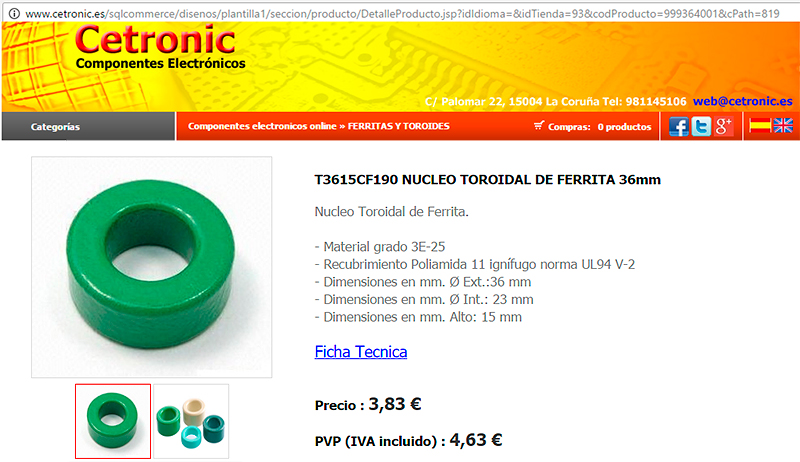
- Ficha técnica T3615CF190
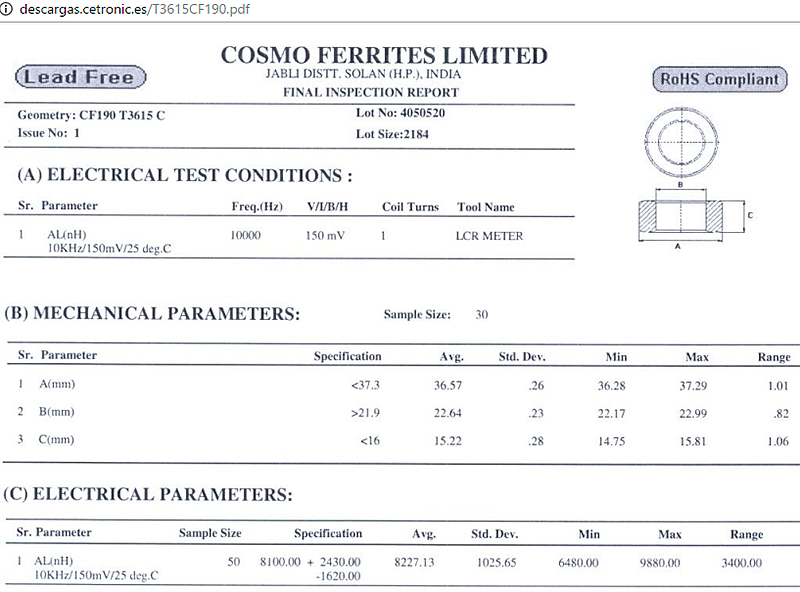
- Información relacionada en:
· Low Power (QRP) Baluns
· ...for feeding the horizontal loop...
· EA3KU experiencia con baluns
· KJ6LRR desventajas hasta un 30% de perdida
· arraysolutions baluns general
73 Carlos EA1DVY
Carlos EC1T
Ex. EA1DVY
Soria in81
Muchas gracias Carlos por toda la info....
73,Quique
QUIQUE - EA1DFP
Hola,
Quique, eso es un simple choque.
Por lo que se ve en la gráfica, va bien de 10 a 40m.
No dice que toroide es exactamente, pero dice;
Escribió:Custom mix low permeability ferrite by Fair Rite
Si eso es cierto, no puede ser un T-xxx ya que son de polvo de hierro.
Si es ferrita será un FT-xxx-xx
El material... creo que es 67, por la cobertura de frecuencias.
Así que solo hay que buscar una ferrita Fair Rite, material 67 y de ese tamaño... por ejemplo; Fair-Rite 5967003801
http://www.fair-rite.com/product/toroids-5967003801/
73, Máximo - EA1DDO
Máximo Martín - EA1DDO / HK1H / M0HAO
EA1DDO@HoTMaiL.com
http://www.EA1DDO.es
QDURE - https://qsl.ure.es
Imprime y confirma tus QSL en tan solo tres click.
Nunca fue tan fácil y cómodo
el confirmar tus contactos.
TIENDA ONLINE URE
Publicaciones, mapas, polos, camisetas, gorras, tazas, forros polares y mucho más...
WEBCLUSTER EA4URE
Conoce el nuevo WebCluster de URE, ahora con nuevos filtros e información y compatible con GDURE



